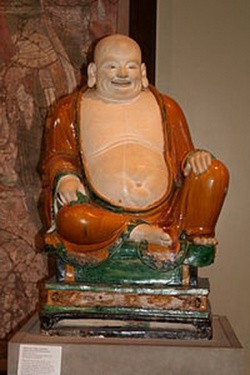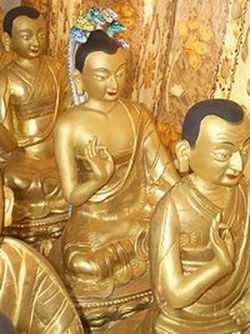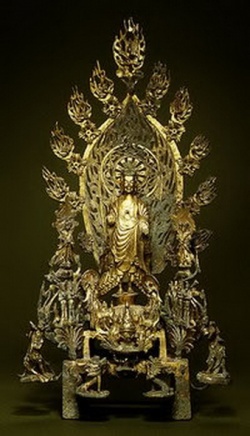Difference between revisions of "The Dhamma: Is it a Philosophy?"
(Created page with "thumb|250px| <poem> The non-aggressive, moral and philosophical system expounded by the Buddha, which demands no blind faith from its adherents, expounds...") |
|||
| (15 intermediate revisions by 4 users not shown) | |||
| Line 1: | Line 1: | ||
[[File:20 fdgf.JPG|thumb|250px|]] | [[File:20 fdgf.JPG|thumb|250px|]] | ||
| − | + | The non-aggressive, [[moral]] and [[philosophical]] system expounded by the [[Buddha]], which demands no [[blind]] [[faith]] from its {{Wiki|adherents}}, expounds no {{Wiki|dogmatic}} creeds, encourages no {{Wiki|superstitious}} [[rites]] and {{Wiki|ceremonies}}, but advocates a golden mean that guides a [[disciple]] through [[pure]] living and [[pure]] [[thinking]] to the gain of [[supreme wisdom]] and [[deliverance]] from all [[evil]], is called the [[Dhamma]] and is popularly known as [[Buddhism]]. | |
| − | + | ||
| + | The all-merciful [[Buddha]] has passed away, but the [[sublime]] [[Dhamma]] which He unreservedly bequeathed to [[humanity]], still [[exists]] in its pristine [[purity]]. | ||
| − | + | Although the [[Master]] has left no written records of His Teachings, His {{Wiki|distinguished}} [[disciples]] preserved them by committing to [[memory]] and transmitting them orally from generation to generation. | |
| − | + | Immediately after His demise 500 chief [[Arahats]] [*] versed in the [[Dhamma]] [**] and [[Vinaya]], [***] held a [[convocation]] to rehearse the [[Doctrine]] as was originally [[taught]] by the [[Buddha]]. [[Venerable]] [[Ananda]] [[Thera]], who enjoyed the special privilege of [[hearing]] all the [[discourses]], recited the [[Dhamma]], while the [[Venerable]] [[Upali]] recited the [[Vinaya]]. | |
| − | + | <nowiki>* [Literally, the [[Worthy]] Ones. They are the [[enlightened]] [[disciples]] who have destroyed all [[passions]]. ** The [[Teaching]]. *** The [[Discipline]].</nowiki> | |
| − | |||
| − | The Tipitaka was compiled and arranged in its present form by those Arahats of old. | + | The [[Tipitaka]] was compiled and arranged in its {{Wiki|present}} [[form]] by those [[Arahats]] of old. |
| − | During the reign of the pious Sinhala King Vattagamani Abhaya, about 83 B.C., the Tipitaka was, for the first time in the history of Buddhism, committed to writing on palm leaves (ola) in Ceylon. | + | During the reign of the pious [[Sinhala]] {{Wiki|King}} [[Vattagamani Abhaya]], about 83 B.C., the [[Tipitaka]] was, for the first [[time]] in the history of [[Buddhism]], committed to [[writing]] on palm leaves (ola) in [[Ceylon]]. |
| − | This voluminous Tipitaka, which contains the essence of the Buddha's Teaching, is estimated to be about eleven times the size of the Bible. A striking contrast between the Tipitaka and the Bible is that the former is not a gradual development like the latter. | + | This voluminous [[Tipitaka]], which contains the [[essence]] of the [[Buddha's Teaching]], is estimated to be about eleven times the size of the Bible. A striking contrast between the [[Tipitaka]] and the Bible is that the former is not a [[gradual]] [[development]] like the [[latter]]. |
| − | As the word itself implies, the Tipitaka consists of three baskets. They are the Basket of Discipline (Vinaya Pitaka), the Basket of Discourses (Sutta Pitaka), and the Basket of Ultimate Doctrine (Abhidhamma Pitaka). | + | As the [[word]] itself implies, the [[Tipitaka]] consists of [[three baskets]]. They are the [[Basket of Discipline]] ([[Vinaya Pitaka]]), the [[Basket of Discourses]] ([[Sutta Pitaka]]), and the [[Basket of Ultimate Doctrine]] ([[Abhidhamma Pitaka]]). |
[[File:20 Nagarjuna.JPG|thumb|250px|]] | [[File:20 Nagarjuna.JPG|thumb|250px|]] | ||
| − | |||
| − | |||
| − | The Vinaya Pitaka consists of the five following books: | + | ===[[Vinaya Pitaka]]=== |
| + | |||
| + | |||
| + | The [[Vinaya Pitaka]] which is regarded as the sheet anchor to the oldest historic [[celibate]] [[order]] -- the [[Sangha]] -- mainly deals with {{Wiki|rules}} and regulations which the [[Buddha]] promulgated, as occasion arose, for the {{Wiki|future}} [[discipline]] of the [[Order]] of [[monks]] ([[Bhikkhus]]) and [[nuns]] ([[Bhikkunis]]). It described in detail the [[gradual]] [[development]] of the [[Sasana]] (Dispensation). An account of the [[life]] and ministry of the [[Buddha]] is also given. Indirectly it reveals some important and [[interesting]] [[information]] about [[ancient]] history, [[Indian]] customs, [[arts]], [[science]], etc. | ||
| + | |||
| + | The [[Vinaya Pitaka]] consists of the five following [[books]]: | ||
| + | <poem> | ||
| + | |||
| + | ([[Vibhanga]]): | ||
| − | + | 1. '''[[Parajika]]''' [[Pali]] -- [[Major Offenses]] | |
| − | 1. Parajika Pali -- Major Offenses | + | 2. '''[[Pacittiya]]''' [[Pali]] -- [[Minor Offenses]] |
| − | 2. Pacittiya Pali -- Minor Offenses | ||
(Khandaka): | (Khandaka): | ||
| − | |||
| − | |||
| − | 5. Parivara Pali -- Epitome of the Vinaya | + | 3. '''[[Mahavagga]]''' [[Pali]] -- [[Greater Section]] |
| + | 4. '''[[Cullavagga]]''' [[Pali]] -- [[Shorter Section]] | ||
| + | 5. '''[[Parivara]]''' [[Pali]] -- [[Epitome of the Vinaya]] | ||
| + | </poem> | ||
| + | |||
| + | ===[[Sutta Pitaka]]=== | ||
| + | |||
| − | Sutta Pitaka | + | The [[Sutta Pitaka]] consists chiefly of [[discourses]], delivered by the [[Buddha]] himself on various occasions. There are also a few [[discourses]] delivered by some of His {{Wiki|distinguished}} [[disciples]] such as the [[Venerable]] [[Sariputta]], [[Ananda]], [[Moggallana]], etc., included in it. It is like a [[book]] of prescriptions, as the sermons [[embodied]] therein were expounded to suit the different occasions and the temperaments of various persons. There may be seemingly [[contradictory]] statements, but they should not be misconstrued as they were opportunely uttered by the [[Buddha]] to suit a particular {{Wiki|purpose}}: for instance, to the self-same question He would maintain [[silence]] (when the inquirer is merely foolishly inquisitive), or give a detailed reply when He knew the inquirer to be an earnest seeker. Most of the sermons were intended mainly for the [[benefit]] of [[Bhikkhus]] and they deal with the {{Wiki|Holy}} [[life]] and with the [[expositions]] of the [[doctrine]]. There are also several other [[discourses]] which deal with both the material and [[moral]] progress of His lay followers. |
| − | |||
[[File:200 dha.jpg|thumb|250px|]] | [[File:200 dha.jpg|thumb|250px|]] | ||
| − | This Pitaka is divided into five Nikayas or collections, viz: | + | This [[Pitaka]] is divided into five [[Nikayas]] or collections, viz: |
| − | 1. Digha Nikaya (Collection of Long Discourses). | + | <poem> |
| − | 2. Majjhima Nikaya (Collection of Middle-Length Discourses). | + | 1. '''[[Digha Nikaya]]''' ([[Collection of Long Discourses]]). |
| − | 3. Samyutta Nikaya (Collection of Kindred Sayings). | + | 2. '''[[Majjhima Nikaya]]''' ([[Collection of Middle-Length Discourses]]). |
| − | 4. Anguttara Nikaya (Collection of Discourses arranged in accordance with numbers). | + | 3. '''[[Samyutta Nikaya]]''' ([[Collection of Kindred Sayings]]). |
| − | 5. Khuddaka Nikaya (Smaller Collection). | + | 4. '''[[Anguttara Nikaya]]''' (Collection of [[Discourses]] arranged in accordance with numbers]]). |
| + | 5. '''[[Khuddaka Nikaya]]''' ([[Smaller Collection]]). | ||
| − | The fifth is subdivided into fifteen books: | + | The fifth is subdivided into fifteen [[books]]: |
| + | |||
| + | 1. '''[[Khuddaka Patha]]''' ([[Shorter texts]]) | ||
| + | 2. '''[[Dhammapada]]''' ([[Way of Truth]]) | ||
| + | 3. '''[[Udana]]''' ([[Paeans of Joy]]) | ||
| + | 4. '''[[Iti Vuttaka]]''' ([["Thus said" Discourses]]) | ||
| + | 5. '''[[Sutta Nipata]]''' ([[Collected Discourses]]) | ||
| + | 6. '''[[Vimana Vatthu]]''' ([[Stories of Celestial Mansions]]) | ||
| + | 7. '''[[Peta Vatthu]]''' ([[Stories of Petas]]) | ||
| + | 8. '''[[Theragatha]]''' ([[Psalms of the Brethren]]) | ||
| + | 9. '''[[Therigatha]]''' ([[Psalms of the Sisters]]) | ||
| + | 10. '''[[Jataka]]''' ([[Birth Stories]]) | ||
| + | 11. '''[[Niddesa]]''' ([[Expositions]]) | ||
| + | 12. '''[[Patisambhida Magga]]''' ([[Analytical Knowledge]]) | ||
| + | 13. [[Apadana]] ([[Lives of Arahats]]) | ||
| + | 14. '''[[Buddhavamsa]]''' (The [[History of the Buddha]]) | ||
| + | 15. '''[[Cariya Pitaka]]''' ([[Modes of Conduct]]) | ||
| + | </poem> | ||
| − | |||
| − | |||
| − | |||
| − | |||
| − | |||
| − | |||
| − | |||
| − | |||
| − | |||
| − | |||
| − | |||
| − | |||
| − | |||
| − | |||
| − | |||
| − | |||
| − | |||
| − | + | ===[[Abhidhamma Pitaka]]=== | |
| − | + | [[File:2011june1.JPG|thumb|250px|]] | |
| + | The [[Abhidhamma Pitaka]] is the most important and the most [[interesting]] of the three, containing as it does the profound [[philosophy]] of the [[Buddha's Teaching]] in contrast to the [[illuminating]] and simpler [[discourses]] in the [[Sutta Pitaka]]. | ||
| − | + | In the [[Sutta Pitaka]] is found the [[Wikipedia:Convention (norm)|conventional]] [[teaching]] ([[vohara desana]]) while in the [[Abhidhamma Pitaka]] is found the [[ultimate teaching]] ([[paramattha-desana]]). | |
| − | + | To the [[wise]], [[Abhidhamma]] is an indispensable [[guide]]; to the [[spiritually]] evolved, an [[intellectual]] treat; and to research [[scholars]], [[food]] for [[thought]]. [[Consciousness]] is defined. [[Thoughts]] are analyzed and classified chiefly from an [[ethical]] standpoint. [[Mental states]] are enumerated. The composition of each type of [[consciousness]] is set forth in detail. How [[thoughts]] arise, is minutely described. Irrelevant problems that [[interest]] mankind but having no [[relation]] to one's [[purification]], are deliberately set aside. | |
| − | + | Matter is summarily discussed; fundamental units of {{Wiki|matter}}, properties of {{Wiki|matter}}, sources of {{Wiki|matter}}, relationship between [[mind]] and {{Wiki|matter}}, are explained. | |
| − | The Abhidhamma | + | The [[Abhidhamma]] investigates [[mind]] and {{Wiki|matter}}, the two composite factors of the so-called [[being]], to help the [[understanding]] of things as they truly are, and a [[philosophy]] has been developed on those lines. Based on that [[philosophy]], an [[ethical]] system has been evolved, to realize the [[ultimate]] goal, [[Nibbana]]. |
| − | 1. Dhammasangani (Classification of Dhammas) | + | The '''[[Abhidhamma Pitaka]]''' consists of seven [[books]]: |
| − | 2. Vibhanga (The book of Divisions) | + | <poem> |
| − | 3. Katha-Vatthu (Points of Controversy) | + | 1. '''[[Dhammasangani]]''' ([[Classification of Dhammas]]) |
| − | 4. Pubbala-Pannatti (Descriptions of Individuals) | + | 2. '''[[Vibhanga]]''' (The [[book of Divisions]]) |
| − | 5. Dhatu-Katha (Discussion with reference to elements) | + | 3. '''[[Katha-Vatthu]]''' ([[Points of Controversy]]) |
| − | 6. Yamaka (The Book of Pairs), | + | 4. '''[[Pubbala-Pannatti]]''' ([[Descriptions of Individuals]]) |
| − | 7. Patthana (The Book of Relations) | + | 5. '''[[Dhatu-Katha]]''' ([[Discussion with reference to elements]]) |
| + | 6. '''[[Yamaka]]''' (The [[Book of Pairs]]), | ||
| + | 7. '''[[Patthana]]''' (The [[Book of Relations]]) | ||
| + | </poem> | ||
[[File:220p 2.jpg|thumb|250px|]] | [[File:220p 2.jpg|thumb|250px|]] | ||
| − | In the Tipitaka one finds milk for the babe and meat for the strong, for the Buddha taught His doctrine both to the masses and to the intelligentsia. The sublime Dhamma enshrined in these sacred texts, deals with truths and facts, and is not concerned with theories and philosophies which may be accepted as profound truths today only to be thrown overboard tomorrow. The Buddha has presented us with no new astounding philosophical theories, nor did He venture to create any new material science. He explained to us what is within and without so far as it concerns our emancipation, as ultimately expounded a path of deliverance, which is unique. Incidentally, He has, however, forestalled many a modern scientist and philosopher. | + | In the [[Tipitaka]] one finds milk for the babe and [[meat]] for the strong, for the [[Buddha]] [[taught]] His [[doctrine]] both to the masses and to the intelligentsia. The [[sublime]] [[Dhamma]] enshrined in these [[sacred]] texts, deals with [[truths]] and facts, and is not concerned with theories and [[philosophies]] which may be accepted as profound [[truths]] today only to be thrown overboard tomorrow. The [[Buddha]] has presented us with no new astounding [[philosophical]] theories, nor did He venture to create any new material [[science]]. He explained to us what is within and without so far as it concerns our [[emancipation]], as ultimately expounded a [[path]] of [[deliverance]], which is unique. Incidentally, He has, however, forestalled many a {{Wiki|modern}} [[scientist]] and [[philosopher]]. |
| − | Schopenhauer in his "World as Will and Idea" has presented the truth of suffering and its cause in a Western garb. Spinoza, though he denies not the existence of a permanent reality, asserts that all phenomenal existence is transitory. In his opinion sorrow is conquered "by finding an object of knowledge which is not transient, not ephemeral, but is immutable, permanent, everlasting." Berkeley proved that the so-called indivisible atom is a metaphysical fiction. Hume, after a relentless analysis of the mind, concluded that consciousness consists of fleeting mental states. Bergson advocates the doctrine of change. Prof. James refers to a stream of consciousness. | + | {{Wiki|Schopenhauer}} in his "[[World]] as Will and [[Idea]]" has presented the [[truth of suffering]] and its [[cause]] in a {{Wiki|Western}} garb. {{Wiki|Spinoza}}, though he denies not the [[existence]] of a [[permanent]] [[reality]], asserts that all [[phenomenal existence]] is transitory. In his opinion [[sorrow]] is conquered "by finding an [[object]] of [[knowledge]] which is not transient, not {{Wiki|ephemeral}}, but is immutable, [[permanent]], everlasting." {{Wiki|Berkeley}} proved that the so-called indivisible {{Wiki|atom}} is a [[metaphysical]] {{Wiki|fiction}}. [[Hume]], after a relentless analysis of the [[mind]], concluded that [[consciousness]] consists of fleeting [[mental states]]. Bergson advocates the [[doctrine]] of change. Prof. James refers to a {{Wiki|stream}} of [[consciousness]]. |
| − | The Buddha expounded these doctrines of Transiency (Anicca), Sorrow (Dukkha), and No-Soul (Anatta) some 2500 years ago while He was sojourning in the valley of the Ganges. | + | The [[Buddha]] expounded these [[doctrines]] of Transiency ([[Anicca]]), [[Sorrow]] ([[Dukkha]]), and No-Soul ([[Anatta]]) some 2500 years ago while He was sojourning in the valley of the [[Ganges]]. |
| − | It should be understood that the Buddha did not preach all that He knew. On one occasion while the Buddha was passing through a forest He took a handful of leaves and said: "O Bhikkhus, what I have taught is comparable to the leaves in my hand. What I have not taught is comparable to the amount of leaves in the forest." | + | It should be understood that the [[Buddha]] did not {{Wiki|preach}} all that He knew. On one occasion while the [[Buddha]] was passing through a {{Wiki|forest}} He took a handful of leaves and said: "O [[Bhikkhus]], what I have [[taught]] is comparable to the leaves in my hand. What I have not [[taught]] is comparable to the amount of leaves in the {{Wiki|forest}}." |
| − | He taught what He deemed was absolutely essential for one's purification making no distinction between an esoteric and exoteric doctrine. He was characteristically silent on questions irrelevant to His noble mission. | + | He [[taught]] what He deemed was absolutely [[essential]] for one's [[purification]] making no {{Wiki|distinction}} between an [[esoteric]] and [[exoteric doctrine]]. He was characteristically [[silent]] on questions irrelevant to His [[noble]] [[mission]]. |
| − | Buddhism no doubt accords with science, but both should be treated as parallel teachings, since one deals mainly with material truths while the other confines itself to moral and spiritual truths. The subject matter of each is different. | + | [[Buddhism]] no [[doubt]] accords with [[science]], but both should be treated as parallel teachings, since one deals mainly with material [[truths]] while the other confines itself to [[moral]] and [[spiritual]] [[truths]]. The [[subject]] {{Wiki|matter}} of each is different. |
| − | The Dhamma He taught is not merely to be preserved in books, nor is it a subject to be studied from an historical or literary standpoint. On the contrary it is to be learnt and put into practice in the course of one's daily life, for without practice one cannot appreciate the truth. The Dhamma is to be studied, and more to be practiced, and above all to be realized; immediate realization is its ultimate goal. As such the Dhamma is compared to a raft which is meant for the sole purpose of escaping from the ocean of birth and death (Samsara). | + | The [[Dhamma]] He [[taught]] is not merely to be preserved in [[books]], nor is it a [[subject]] to be studied from an historical or {{Wiki|literary}} standpoint. On the contrary it is to be learnt and put into practice in the course of one's daily [[life]], for without practice one cannot appreciate the [[truth]]. The [[Dhamma]] is to be studied, and more to be practiced, and above all to be [[realized]]; immediate [[realization]] is its [[ultimate]] goal. As such the [[Dhamma]] is compared to a raft which is meant for the sole {{Wiki|purpose}} of escaping from the ocean of [[birth]] and [[death]] ([[Samsara]]). |
| − | Buddhism, therefore, cannot strictly be called a mere philosophy because it is not merely the "love of, inducing the search after, wisdom." Buddhism may approximate a philosophy, but it is very much more comprehensive. | + | [[Buddhism]], therefore, cannot strictly be called a mere [[philosophy]] because it is not merely the "[[love]] of, inducing the search after, [[wisdom]]." [[Buddhism]] may approximate a [[philosophy]], but it is very much more comprehensive. |
| + | |||
| + | [[Philosophy]] deals mainly with [[knowledge]] and is not concerned with practice; whereas [[Buddhism]] lays special {{Wiki|emphasis}} on practice and [[realization]]. | ||
| − | |||
| − | |||
{{R}} | {{R}} | ||
[http://www.budsas.org/ebud/nutshell/nshell02.htm www.budsas.org] | [http://www.budsas.org/ebud/nutshell/nshell02.htm www.budsas.org] | ||
[[Category:Buddhist Texts]] | [[Category:Buddhist Texts]] | ||
[[Category:Dharma]] | [[Category:Dharma]] | ||
| − | + | ||
[[Category:Buddhist Terms]] | [[Category:Buddhist Terms]] | ||
Latest revision as of 02:25, 24 January 2015
The non-aggressive, moral and philosophical system expounded by the Buddha, which demands no blind faith from its adherents, expounds no dogmatic creeds, encourages no superstitious rites and ceremonies, but advocates a golden mean that guides a disciple through pure living and pure thinking to the gain of supreme wisdom and deliverance from all evil, is called the Dhamma and is popularly known as Buddhism.
The all-merciful Buddha has passed away, but the sublime Dhamma which He unreservedly bequeathed to humanity, still exists in its pristine purity.
Although the Master has left no written records of His Teachings, His distinguished disciples preserved them by committing to memory and transmitting them orally from generation to generation.
Immediately after His demise 500 chief Arahats [*] versed in the Dhamma [**] and Vinaya, [***] held a convocation to rehearse the Doctrine as was originally taught by the Buddha. Venerable Ananda Thera, who enjoyed the special privilege of hearing all the discourses, recited the Dhamma, while the Venerable Upali recited the Vinaya.
* [Literally, the [[Worthy]] Ones. They are the [[enlightened]] [[disciples]] who have destroyed all [[passions]]. ** The [[Teaching]]. *** The [[Discipline]].
The Tipitaka was compiled and arranged in its present form by those Arahats of old.
During the reign of the pious Sinhala King Vattagamani Abhaya, about 83 B.C., the Tipitaka was, for the first time in the history of Buddhism, committed to writing on palm leaves (ola) in Ceylon.
This voluminous Tipitaka, which contains the essence of the Buddha's Teaching, is estimated to be about eleven times the size of the Bible. A striking contrast between the Tipitaka and the Bible is that the former is not a gradual development like the latter.
As the word itself implies, the Tipitaka consists of three baskets. They are the Basket of Discipline (Vinaya Pitaka), the Basket of Discourses (Sutta Pitaka), and the Basket of Ultimate Doctrine (Abhidhamma Pitaka).
Vinaya Pitaka
The Vinaya Pitaka which is regarded as the sheet anchor to the oldest historic celibate order -- the Sangha -- mainly deals with rules and regulations which the Buddha promulgated, as occasion arose, for the future discipline of the Order of monks (Bhikkhus) and nuns (Bhikkunis). It described in detail the gradual development of the Sasana (Dispensation). An account of the life and ministry of the Buddha is also given. Indirectly it reveals some important and interesting information about ancient history, Indian customs, arts, science, etc.
The Vinaya Pitaka consists of the five following books:
(Vibhanga):
1. Parajika Pali -- Major Offenses
2. Pacittiya Pali -- Minor Offenses
(Khandaka):
3. Mahavagga Pali -- Greater Section
4. Cullavagga Pali -- Shorter Section
5. Parivara Pali -- Epitome of the Vinaya
Sutta Pitaka
The Sutta Pitaka consists chiefly of discourses, delivered by the Buddha himself on various occasions. There are also a few discourses delivered by some of His distinguished disciples such as the Venerable Sariputta, Ananda, Moggallana, etc., included in it. It is like a book of prescriptions, as the sermons embodied therein were expounded to suit the different occasions and the temperaments of various persons. There may be seemingly contradictory statements, but they should not be misconstrued as they were opportunely uttered by the Buddha to suit a particular purpose: for instance, to the self-same question He would maintain silence (when the inquirer is merely foolishly inquisitive), or give a detailed reply when He knew the inquirer to be an earnest seeker. Most of the sermons were intended mainly for the benefit of Bhikkhus and they deal with the Holy life and with the expositions of the doctrine. There are also several other discourses which deal with both the material and moral progress of His lay followers.
This Pitaka is divided into five Nikayas or collections, viz:
1. Digha Nikaya (Collection of Long Discourses).
2. Majjhima Nikaya (Collection of Middle-Length Discourses).
3. Samyutta Nikaya (Collection of Kindred Sayings).
4. Anguttara Nikaya (Collection of Discourses arranged in accordance with numbers]]).
5. Khuddaka Nikaya (Smaller Collection).
The fifth is subdivided into fifteen books:
1. Khuddaka Patha (Shorter texts)
2. Dhammapada (Way of Truth)
3. Udana (Paeans of Joy)
4. Iti Vuttaka ("Thus said" Discourses)
5. Sutta Nipata (Collected Discourses)
6. Vimana Vatthu (Stories of Celestial Mansions)
7. Peta Vatthu (Stories of Petas)
8. Theragatha (Psalms of the Brethren)
9. Therigatha (Psalms of the Sisters)
10. Jataka (Birth Stories)
11. Niddesa (Expositions)
12. Patisambhida Magga (Analytical Knowledge)
13. Apadana (Lives of Arahats)
14. Buddhavamsa (The History of the Buddha)
15. Cariya Pitaka (Modes of Conduct)
Abhidhamma Pitaka
The Abhidhamma Pitaka is the most important and the most interesting of the three, containing as it does the profound philosophy of the Buddha's Teaching in contrast to the illuminating and simpler discourses in the Sutta Pitaka.
In the Sutta Pitaka is found the conventional teaching (vohara desana) while in the Abhidhamma Pitaka is found the ultimate teaching (paramattha-desana).
To the wise, Abhidhamma is an indispensable guide; to the spiritually evolved, an intellectual treat; and to research scholars, food for thought. Consciousness is defined. Thoughts are analyzed and classified chiefly from an ethical standpoint. Mental states are enumerated. The composition of each type of consciousness is set forth in detail. How thoughts arise, is minutely described. Irrelevant problems that interest mankind but having no relation to one's purification, are deliberately set aside.
Matter is summarily discussed; fundamental units of matter, properties of matter, sources of matter, relationship between mind and matter, are explained.
The Abhidhamma investigates mind and matter, the two composite factors of the so-called being, to help the understanding of things as they truly are, and a philosophy has been developed on those lines. Based on that philosophy, an ethical system has been evolved, to realize the ultimate goal, Nibbana.
The Abhidhamma Pitaka consists of seven books:
1. Dhammasangani (Classification of Dhammas)
2. Vibhanga (The book of Divisions)
3. Katha-Vatthu (Points of Controversy)
4. Pubbala-Pannatti (Descriptions of Individuals)
5. Dhatu-Katha (Discussion with reference to elements)
6. Yamaka (The Book of Pairs),
7. Patthana (The Book of Relations)
In the Tipitaka one finds milk for the babe and meat for the strong, for the Buddha taught His doctrine both to the masses and to the intelligentsia. The sublime Dhamma enshrined in these sacred texts, deals with truths and facts, and is not concerned with theories and philosophies which may be accepted as profound truths today only to be thrown overboard tomorrow. The Buddha has presented us with no new astounding philosophical theories, nor did He venture to create any new material science. He explained to us what is within and without so far as it concerns our emancipation, as ultimately expounded a path of deliverance, which is unique. Incidentally, He has, however, forestalled many a modern scientist and philosopher.
Schopenhauer in his "World as Will and Idea" has presented the truth of suffering and its cause in a Western garb. Spinoza, though he denies not the existence of a permanent reality, asserts that all phenomenal existence is transitory. In his opinion sorrow is conquered "by finding an object of knowledge which is not transient, not ephemeral, but is immutable, permanent, everlasting." Berkeley proved that the so-called indivisible atom is a metaphysical fiction. Hume, after a relentless analysis of the mind, concluded that consciousness consists of fleeting mental states. Bergson advocates the doctrine of change. Prof. James refers to a stream of consciousness.
The Buddha expounded these doctrines of Transiency (Anicca), Sorrow (Dukkha), and No-Soul (Anatta) some 2500 years ago while He was sojourning in the valley of the Ganges.
It should be understood that the Buddha did not preach all that He knew. On one occasion while the Buddha was passing through a forest He took a handful of leaves and said: "O Bhikkhus, what I have taught is comparable to the leaves in my hand. What I have not taught is comparable to the amount of leaves in the forest."
He taught what He deemed was absolutely essential for one's purification making no distinction between an esoteric and exoteric doctrine. He was characteristically silent on questions irrelevant to His noble mission.
Buddhism no doubt accords with science, but both should be treated as parallel teachings, since one deals mainly with material truths while the other confines itself to moral and spiritual truths. The subject matter of each is different.
The Dhamma He taught is not merely to be preserved in books, nor is it a subject to be studied from an historical or literary standpoint. On the contrary it is to be learnt and put into practice in the course of one's daily life, for without practice one cannot appreciate the truth. The Dhamma is to be studied, and more to be practiced, and above all to be realized; immediate realization is its ultimate goal. As such the Dhamma is compared to a raft which is meant for the sole purpose of escaping from the ocean of birth and death (Samsara).
Buddhism, therefore, cannot strictly be called a mere philosophy because it is not merely the "love of, inducing the search after, wisdom." Buddhism may approximate a philosophy, but it is very much more comprehensive.
Philosophy deals mainly with knowledge and is not concerned with practice; whereas Buddhism lays special emphasis on practice and realization.




